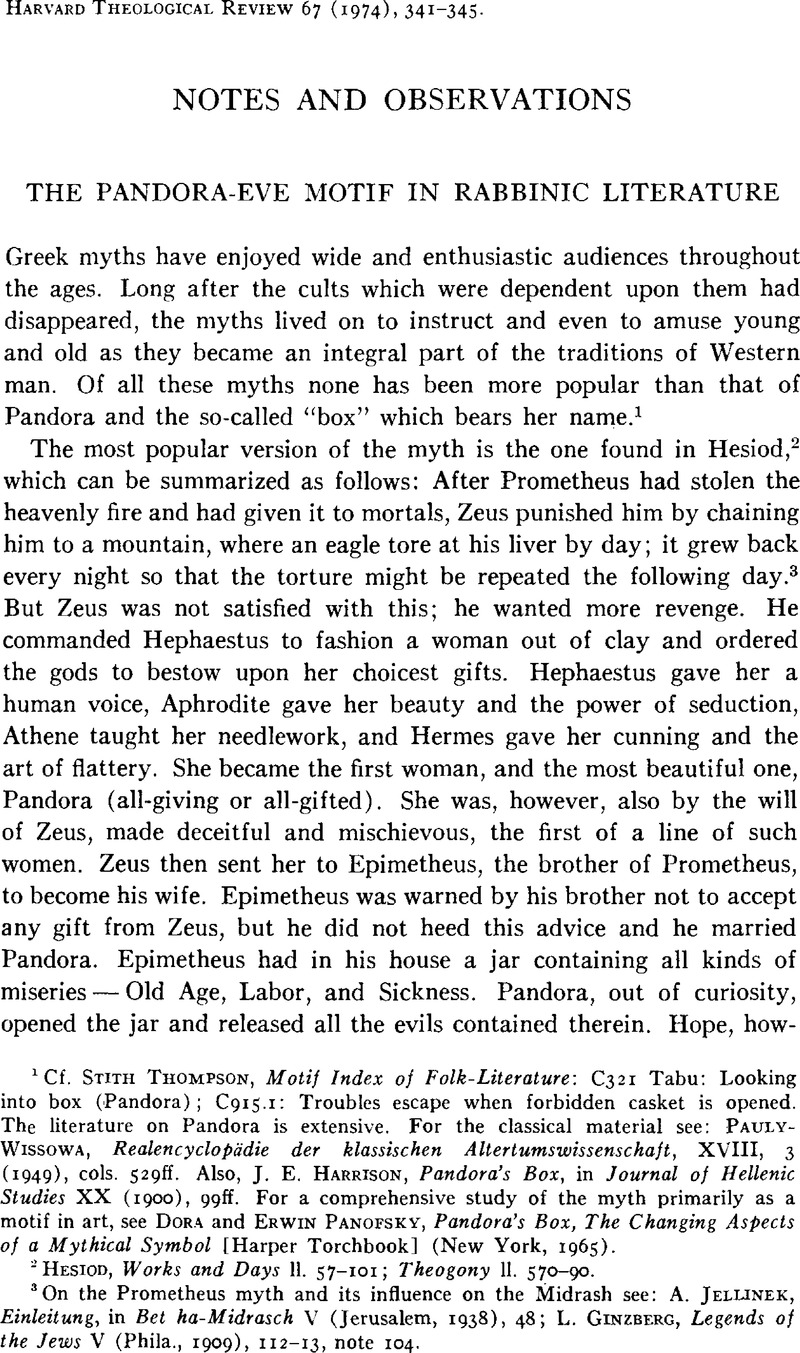Article contents
The Pandora-Eve Motif in Rabbinic Literature
Published online by Cambridge University Press: 10 June 2011
Abstract

- Type
- Notes and Observations
- Information
- Copyright
- Copyright © President and Fellows of Harvard College 1974
References
1 Cf. Stith Thompson, Motif Index of Folk-Literature: C321 Tabu: Looking into box (Pandora); C915.1: Troubles escape when forbidden casket is opened. The literature on Pandora is extensive. For the classical material see: Pauly-Wissowa, Realencydopädie der klassischen Altertumswissenschaft, XVIII, 3 (1949), cols. 529ff. Also, Harrison, J. E., Pandora's Box, in Journal of Hellenic Studies XX (1900), 99ff.CrossRefGoogle Scholar For a comprehensive study of the myth primarily as a motif in art, see , Dora and Panofsky, Erwin, Pandora's Box, The Changing Aspects of a Mythical Symbol [Harper Torchbook] (New York, 1965).Google Scholar
2 Hesiod, Works and Days ll. 57–101; Theogony ll. 570–90.
3 On the Prometheus myth and its influence on the Midrash see: Jelunek, A., Einleitung, in Bet ha-Midrasch V (Jerusalem, 1938), 48Google Scholar; Ginzberg, L., Legends of the Jews V (Phila., 1909), 112–13, note 104.Google Scholar
4 According to a later story (Babrius, Fabulae Aesopeae 58) the jar contained not evils but blessings which would have been preserved for mankind had they not been lost out of curiosity by man himself by the opening of the jar. For further parallels among other peoples see: J. Frazer, Pausanias ii 320.
5 Gen. 2–3. Cf. Origen, Contra Celsum IV; Gregory of Nazianzus, Adversus mulieres se nitnis ornantes ll. 155ff.
6 Tertullian, Adversus Valentinianos XII, “Hesiodi Pandora.”
7 Idem, De corona militis VII: ”Si fuit aliqua Pandora quam quam primam foeminarum memorat Hesiodus, hoc primum caput coronatum est a Charitibus, cum ab omnibus muneraretur, unde Pandora. Nobis vero Moyses, prophelicus, non poeticus pastor, principem joeminam Evam facilius pudenda foliis, quam tempora floribus, incinctam describit. Nulla ergo Pandora.”
8 Cf. Lieberman, S., Greek in Jewish Palestine (New York, 1942)Google Scholar, Hellenism in Jewish Palestine (New York, 1950). In the latter work (p. 136, note 86) Lieberman calls attention to the Pandora-Eve motif. Cf. also M. Steinschneider, Hamazkir XIV, 84–85.Google Scholar
9 Midrash Hallel in Jellinek's BHM V, 90. The other versions are: Aboth de Rabbi Nathan, ed. Schechter, S. (New York, 1945)Google Scholar, II, ch. 1, p. 7, in the name of Rabbi (Judah the Prince), in which the king is Adam. It concludes with Gen. 3.1, Now the serpent was more subtle than any beast of the field. Ibid., I, ch. i, p. 6, in the name of R. Simeon. Here only one scorpion is mentioned, together with “figs and nuts” in the jar. This version omits the borrowing of the vinegar. The text concludes, “This is what Adam was like when the Holy One blessed be He said to him, ‘of every tree of the garden you may freely eat, but of the tree of knowledge of good and evil you shall not eat of it, for in the day that you eat of it you shall surely die’ (Ibid. 2.16–17). When he ate of it, he was banished, confirming what is said, but man does not abide in honor but he is like the beasts that perish (Ps. 49.13).” Cf. the same version in Yalkut ha-Makiri to Ps. 49, ed. Buber, S. (Berdychev, 1899), 270Google Scholar, which contains a slight variant — “figs, nuts and pomegranates.” See on the relationship of the texts, Finkelstein, L., Mabo le Mesektot Abot we Abot d'Rabbi Natan [Hebrew] (New York, 1950), 117.Google ScholarGenesis Rabba, ed. Theodor, J. (Berlin, 1912), 179–80Google Scholar, in the name of R. Levi. It is based on Gen. 3.10–11 and concludes with Ibid. 3.11. The husband is described as a Habar (snake charmer?), and the jar contains snakes and scorpions. This passage is also cited in Yalkut Shimoni, I, 28. Pirke de Rabbi Eliezer (Warsaw, 1853), ch. 13, p. 32.Google Scholar Here the jar contains scorpions. The distinctive features are that Adam is the king, and an old man, not an old woman, is the borrower of the vinegar. The passage ends with Ps. 36.13: There the workers of iniquity have fallen.
10 Gen. 2.16–17. Hesiod, Works and Days ll. 85–86.
11 Gen. 3.20. Hesiod, Theogony l. 590.
12 Works and Days ll. 90–95.
13 For example, Luria to PRE explains it on the basis of Ps. 8.7: “You have made him to have dominion over the works of Your hands.”
14 All versions have “an (old) woman” or “old man” borrowing vinegar except ARN I, which is defective.
15 Cf. Pseudo-Rashi to Gen.R., loc. cit., who suggests that it was “hot water for kneading” but then rejects this in favor of “vinegar,” comparing it to “the sour grapes” of Ezek. 18.2 and Jer. 31.29. The commentary Matnot Kehunah ad loc. connects it with the verse in Prov. 10.26: “As vinegar to the teeth and as smoke to the eyes.” Luria to PRE, loc. cit., comments that the poor used to dip their bread in vinegar and cites as proof ARN, ch. 20, where it is stated that he who lacks everything means that he does not even have vinegar (for his bread).
16 See Theodor, variae lectiones ad loc.
17 Gen. 3.13.
18 TJ Ber. 7d; TB Ber. 17a; Leviticus Rabba 13; Zohar, Gen., p. 182.
19 See Lachs, S. T., Serpent Folklore in Rabbinic Literature, in Jewish Social Studies XXVII (1965), 181–83.Google Scholar
20 See Pauly-Wissowa, op. cit., col. 534ff. Panofsky, op. cit., 8, note 10.
21 Cf. Krauss, S., Talmudische Archäologie (Leipzig, 1911), II, 236, 273, 275, 290.Google Scholar
22 See Alphabetum Siracidis, ed. Steinschneider, M. (Berlin, 1858), Version II, p. 21a, where both snakes and scorpions were placed in a container to prove a point and to punish adversaries.Google Scholar
23 Cf. TB Ber. 33a, Gen.R. 84 et al.
- 5
- Cited by


